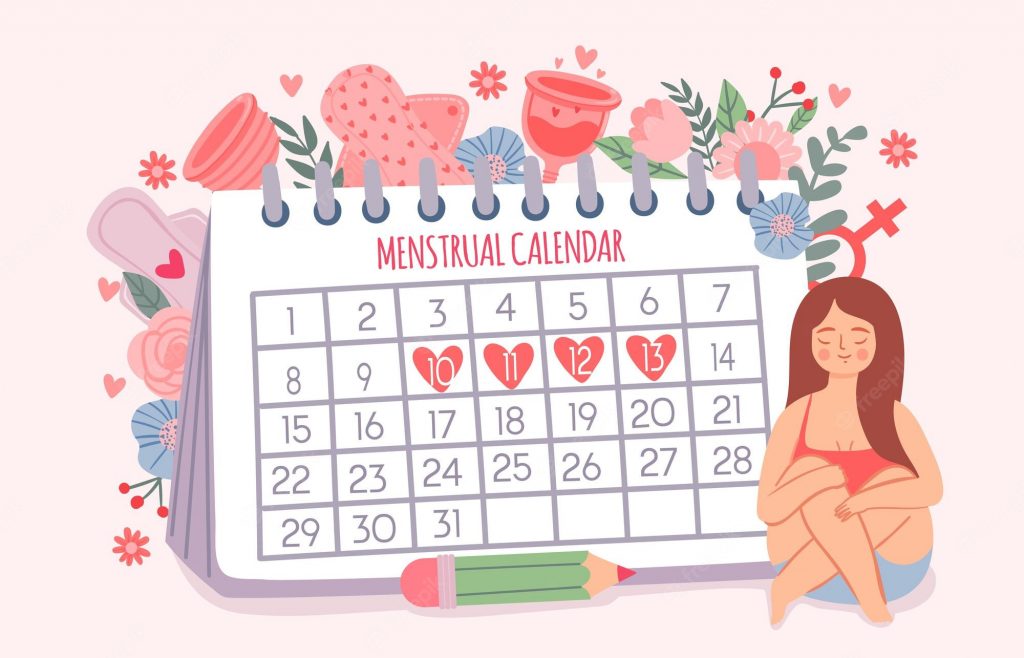What Does My Menstrual Cycle Have To Do With Pregnancy?
Menstrual cycle has become a rather popular topic nowadays. Mostly, the talk is centered around period poverty and sustainable period products but not about the actual science of menstruation. It’s a sad truth that many menstruating people as well as non-menstruating people still don’t know why periods take place, what menstrual cycle has to do with pregnancy, when someone is ovulating, when the risk of unwanted pregnancy is lower and things like that.
This blog hopes to provide knowledge to those who want to know about the science of menstruation, its phases and most importantly, how significant is the ovulation phase if you are trying to get pregnant or even when you are trying to avoid an unwanted pregnancy.

Menstruation Vs Menstrual Cycle
Menstruation and menstrual cycle sounds very similar but they mean different things and it’s important to know the significance of those two words. Menstruation is the monthly shedding of the lining of the uterus commonly known as periods whereas the menstrual cycle is a term used to describe the phases that occur within someone’s body as it prepares for the possibility of pregnancy every month. The steps in the menstrual cycle are triggered by the rise and fall of hormones in one’s body which are released from the pituitary gland in the brain and the ovaries during certain times in the menstrual cycle. This makes the reproductive organs respond in a certain way like influencing the development of eggs in the ovaries and the growth of a thick lining inside the uterus.
A normal cycle length can vary between 21 to 35 days with an average of 28 days. In ancient times, it was believed that female fertility was linked to the lunar calendar but recent studies have shown that there’s no correlation between the two. Since the lunar cycle is roughly 29.5 days whereas the menstrual cycle is normally 21-35 days. The cycle isn’t the same from person to person but for an individual during their lifetime as well. The same can’t be said for the lunar cycle. The menstruating body isn’t a clockwork mechanism, it is influenced by many factors such as stress, illness, diet, physical activity and other factors. People also start to menstruate at different ages. People usually start menstruating at the average age of 12 but they can start their periods as early as 8 or as late as 16 years old.
Phases of the Menstrual Cycle
There are technically four phases in the menstrual cycle if pregnancy does not take place before the end but the main phases are the first three only since the last phase can change on the basis of fertilisation of the egg and continue to be periods or pregnancy. The phases are best known as Follicular phase, Ovulation, Luteal phase and Menses/Periods phase and we are going to learn more about them –
Follicular Phase : The eggs in the ovaries are stored in pockets/bags called follicles. Follicular phase marks the first day of menstruation. In this phase, an egg matures in the ovary. During this time, Estrogen and progesterone levels increase which causes the lining of the uterus also known as endometrium, to thicken in order to prepare the egg for the upcoming ovulation phase. The egg inside the ovary matures (ovum) with the help of a hormone named follicle-stimulating hormone in this phase.
Ovulation : During this phase, the ovary releases the mature egg and the uterus prepares to receive a fertilised egg. The egg travels through one of the fallopian tubes to reach the uterus. It roughly happens around the 14th day of someone’s cycle. Another hormone named luteinising hormone is the reason that causes the ovary to release its egg. It awaits fertilisation by a sperm cell in the fallopian tube. The average lifespan of an egg is about one day whereas a sperm can stay active for up to 5 days in the body. If a person is trying to get pregnant or wants to avoid unwanted pregnancies, this is the most important time they have to keep on track. There’s many ways to keep track of one’s fertile days.
The day of ovulation can be detected with the help of methods like basal temperature charts, monitoring changes in cervical mucus, home tests for ovulation, ultrasound, etc. We are going to talk about some methods that are easy to do and keep track of ovulation in this blog later on.

Luteal Phase : If at the end of this phase, the released egg isn’t fertilised, the uterine lining sheds and the person’s periods begin and if it is fertilised, the zygote (egg fertilised by sperm) attaches itself to the endometrium to become a fetus and the first trimester of the pregnancy starts. This phase lasts for 10 to 16 days, unlike the follicular phase, this phase tends to be more consistent. If one has a 28 days cycle, the follicular and luteal phases are roughly equal in length, around 14 days each. The follicular phase can vary in length while the luteal phase’s length is quite stable and that’s why ovulation does not exactly occur on day 14 of the cycle.
Menses Phases : A sharp decline in the estrogen and progesterone levels are one of the factors that trigger menstruation. The endometrium begins to shed because pregnancy has occurred. The menstrual blood – which is partly blood and partly tissue from the inside of the uterus – flows from the uterus through the cervix and out of the body through the vagina. Most people bleed for 3 to 5 days, but a period lasting only 2 days to as many as seven days is still considered normal. Bleeding gradually decreases when periods are ending, so it’s normal to have 1-2 days of light bloody discharge after that many days of bleeding. The period is considered complete only when the discharge starts becoming clearer.
Medical Concerns about Menstruation
Long periods or absence of periods are both not a common thing that can happen and it could mean a lot of things. A period lasting for more than 7 days is considered abnormal uterine bleeding. Changes in hormones can lead to the overgrowth and abnormal development of the endometrium and can cause longer periods as well as other factors like mental and/or physical overexertion, significant weight loss or gain, stress, climate change, Vitamin C, E or K deficiency, intoxication, acute and chronic medical conditions, gynaecological conditions like fibroids, uterine polyps, adenomyosis, blood coagulation disorder, liver and thyroid gland malfunctions. We have a blog about menstrual disorders that goes in detail to help you understand better about these conditions.
The absence of periods is generally associated with pregnancy but that is not always the case. Losing sudden weight, breastfeeding, taking or stopping taking antidepressants and hormonal contraceptives, having conditions like PCOS, gynaecological anomalies, endocrine system disorders, etc can cause late periods and irregular cycles. In case, if someone had unprotected vaginal intercourse during their last cycle no matter what phase and they still haven’t gotten their periods, it is best to take a pregnancy test first to know for sure.
Calculating One’s Fertile Days
Like we talked about before, since the egg only lives up to one day and a sperm cell up to five days inside a body during the ovulation phase, the fertile window is a favourable time to get pregnant begins 5 days before ovulation, the ovulation day itself and the day after it. Keeping track of it helps with natural family planning and helps the person know their body more.
The most accurate way to determine ovulation is a pelvic ultrasound scan but it’s considered expensive and time-consuming. Home urinary luteinising hormone (LH) tests also exist in India but they are difficult to get ahold of. Measuring one’s basal body temperature (BBT) can also help determine when ovulation occurs. BBT is the lowest natural temperature that the body reaches after a period of rest. The temperature can be taken with a thermometer orally, vaginally or rectally at home and sticking with one way will help avoid inconsistencies. It fluctuates with the cycle, so it definitely helps to take the temperature everyday and keep track of it. Certain factors alter the BBT results as well like fever, stress, alcohol, travel, etc. This article goes into details about how BBT actually works and if you think this could work for your body, then do give it a read.

The easiest way to keep track of ovulation without requiring any apparatus is by monitoring changes in cervical mucus. Cervical mucus is a watery secretion produced by the cervix and vagina. It comes out of the vagina as discharge. Vaginal discharge changes throughout different phases of the menstrual cycle and you might have even noticed. Its amount, color and consistency depends on the levels of the estrogen in the body which is produced by the developing egg.
After periods, estrogen levels are quite low, so typically it’s followed by vaginal dryness when little to no discharge is produced and it’s barely visible on your underwear. Then, the mucus starts getting sticky and not stretchy between the fingers. This is the follicular phase where the discharge is pearly, white or yellowish. As ovulation approaches, the amount of discharge increases and it becomes runny, clear and watery. It becomes stretchy, somewhat transparent and is egg white in colour which makes it easier for the sperm to enter the cervix for fertilisation. In the luteal phase, the amount of discharge decreases and it gets sticky and not stretchy again and the cycle continues.
Conclusion.
We hope we answered the question about how the menstrual cycle and pregnancy are interdependent on each other. It is still not common knowledge how periods actually take place and how pregnancy begins and when you are most likely to get pregnant, so myths and pseudoscience take place instead of actual facts. The menstrual cycle is a pretty straight forward cycle with day 1 as the start of the cycle, day 14 as the crucial day that is ovulation and the time you are most likely to get pregnant and day 21 where pregnancy is less likely but there’s always a chance so if you don’t wish for an unplanned pregnancy, it’s always wise to wear protection or take contraceptives.
Pregnancy and its relationship with menstruation can be very fickle since there have been instances of pregnancy taking place while someone’s pregnant or the concept of implantation bleeding which happens around the same time as someone’s regular periods are supposed to take place. But with practice and time, it will no longer be that difficult to understand the science behind the menstrual cycle and how to keep track of it to create a natural family planning chart.
Author


1 thought on “What Does My Menstrual Cycle Have To Do With Pregnancy?”
Such an informative blog